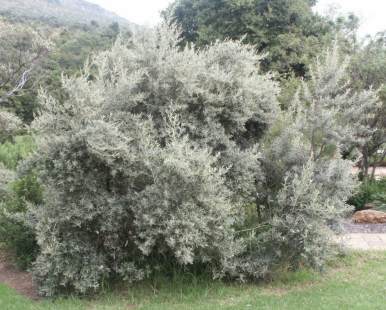Tarchonanthus camphoratus
Tarchonanthus camphoratus L.
Family: Asteraceae
Common names: camphor bush (E), moologa (V), mofahlana (S.Sotho), igqeba emlimhlophe (Z), wildekanferbos (A), mofathla (T)
SA Tree No: 733
Introduction
This interesting small tree with its attractive grey foliage is particularly suited to tough conditions. It was a very variable and widespread species occurring from the coast to dry inland areas. However, the species was split into 5 different species in 2002. Tarchonanthus camphoratus is the tree of dry inland gardens in the north of the country and Tarchonanthus littoralis grows on the coast. Please see T. littoralis for more details of the reclassification.

Description
Description
Tarchonanthus camphoratus grows from 2-9 m high. It is a semi-deciduous small tree that grows mostly in large uniform groups, but it grows larger and more densely when it grows alone among other trees in the bush. The branches and foliage make a V-shaped canopy. The stem is covered with pale brown bark. Leaves are grey green above and pale grey and felted underneath, with prominent venation on the underside. The leaves are narrow, with entire or finely toothed margins.
The creamy-white flowers are borne in a branched inflorescence on the terminal end of the branch. The fruits are covered with fluffy cotton wool-like hairs, and are produced mostly in March to November. These woolly, white fruiting heads are strongly scented and most attractive. Male and female flowers are borne on separate trees.
Conservation Status
Status
According to the Red List of South African Plants, Tarchonanthus camphoratus is assessed as Least Concern (LC).
Distribution and habitat
Distribution description
Tarchonanthus camphoratus is widely distributed in a variety of habitats, including thickets of bushveld, grassland, forest and semi-desert, in the northern part of southern Africa from Namibia, Botswana, Limpopo, North-West, Gauteng, Free State and Northern Cape as well as in tropical and north Africa and the Arabian Peninsula.
See Tarchonanthus littoralis for more information on the distribution of the species that make up the T. camphoratus complex.
Derivation of name and historical aspects
History
The name Tarchonanthus is derived from the Greek word meaning funeral flower. This name is divided into two parts, tarchos, which means 'funeral rites' and anthos meaning 'flower'. It is unclear why this name was given, but Jackson (1990) suggests it may have to do with the camphorous smell. The name camphoratus refers to the strong smell of camphor given off when the leaves are crushed.
There are 7 species of Tarchonanthus in South Africa, and of these, T. littoralis and T. trilobus are also in cultivation. The genus occurs in Africa and Arabia. It is closely related to Brachylaena, which also provides attractive, grey-leafed, small trees for the garden.
See Tarchonanthus littoralis for updated taxonomic information on this genus.
Ecology
Ecology
Animals such as kudu, giraffe, impala and springbok browse the leaves of this tree, but only in times of need or drought. This tough tree can shoot from the base after fire.
Uses
Use
The camphor bush is used for medicinal purposes. Problems such as blocked sinuses and headache can be healed by inhaling the smoke from the burning green leaves. Drinking boiled mixture of leaves and water can help to treat coughing, toothache, abdominal pain and bronchitis. Leaves can also be used for massaging body stiffness and also as a perfume. The cotton wool-like seedheads were used to stuff cushions.
Growing Tarchonanthus camphoratus
Grow
This tree can be used in the garden for areas with severe frost and drought. It is also an excellent tree for creating tall hedges or windbreaks in coastal gardens and for binding sand dunes. It provides a good shape and it can be also used as a bonsai specimen.
Propagate this tree from seed, which may take 8 weeks to germinate. It may also be propagated by softwood cuttings. Young plants transplant fairly easily. The tree requires no special nurturing.
References
- Grant, R and Thomas, V. 1998. Sappi Tree Spotting Kwazulu-Natal. Jacana Publishers. Johannesburg.
- Herman, P.P.J. 2002. Revision of the Tarchonanthus camphoratus complex (Asteraceae-Tarchonantheae) in southern Africa. Bothalia 32: 21-28.
- Jackson, W.P. 1990. Origins and Meanings of Names of South Africa. UCT Publishers. Cape Town.
- Palmer, E. and Pitman, N. 1973. Trees of Southern Africa. A.A.Balkema. Cape Town.
- Pooley, E. 1993. Trees of Natal. Natal Flora Publication. Durban.
- Van Wyk, B and Van Wyk, P. 1997. Trees of Southern Africa. Struik Publishers. Cape Town.
Credits
Samson Moeketsi Letsela and Andrew Hankey
Witwatersrand National Botanical Garden
with additions by Yvonne Reynolds
May 2002
Plant Attributes:
Plant Type: Shrub, Tree
SA Distribution: Free State, Gauteng, Limpopo, Mpumalanga, North West, Northern Cape
Soil type: Clay, Loam, Brack/saline
Flowering season: Late Summer, Autumn, Winter
PH: Alkaline, Neutral
Flower colour: White
Aspect: Full Sun
Gardening skill: Easy
Special Features:
Horticultural zones











Rate this article
Article well written and informative
Rate this plant
Is this an interesting plant?
Login to add your Comment
Back to topNot registered yet? Click here to register.